
Rick Mills – Rackla Upsizes Drill Program at Grad to 5,000m
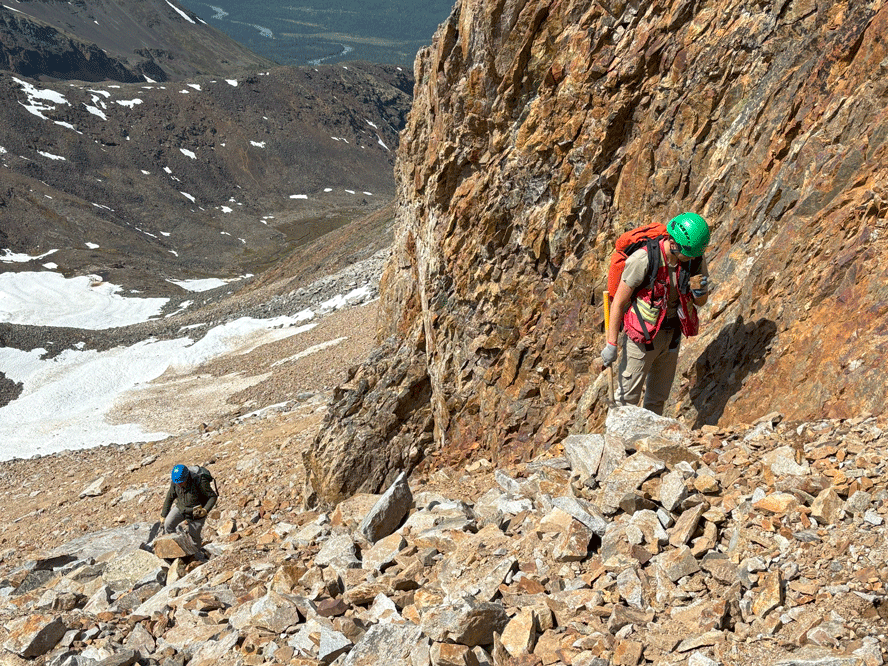
Rackla Metals (TSX-V:RAK) is targeting Reduced Intrusion-Related Gold Systems (RIRGS) mineralization on the southeastern part of the Tombstone Gold Belt in Canada’s eastern Yukon and western Northwest Territories.
The Vancouver-based company started its 2025 drill program in mid-July at the BiTe Zone on the Grad property in the NWT. The original goal of 4,000 meters has been upsized to 5,000m due to encouraging observations in the drill core and surface work.
Rackla Metals
Rackla is run by one of the legends in the gold mining business, Chief Executive Simon Ridgway, who founded Fortuna Silver, Radius Gold, and is also the CEO of Volcanic Gold.
After discovering several precious metals deposits in Central America and Mexico, four of which became mines, the veteran mining financer turned his attention to large-scale RIRGS in the Tombstone Gold Belt (TGB) – part of the Tintina gold province that extends from the Northwest Territories to the Yukon and into Alaska.
Following Snowline Gold’s discovery of the Valley deposit in the Yukon portion of the TGB, Ridgway began researching the Tombstone intrusive bodies to the east of Snowline and discovered none of them had been prospected historically for gold.
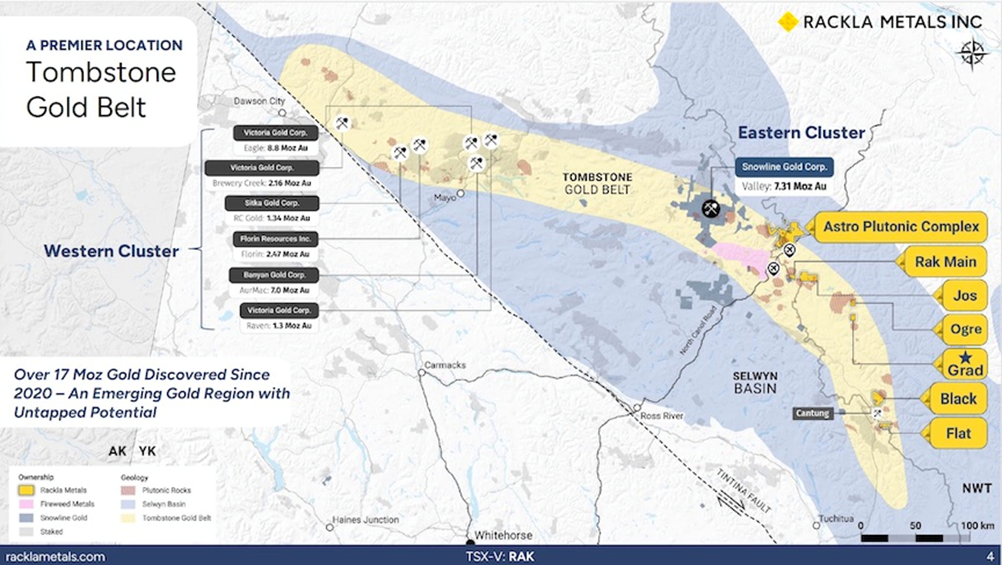
Tombstone Gold Belt — Western and Eastern clusters
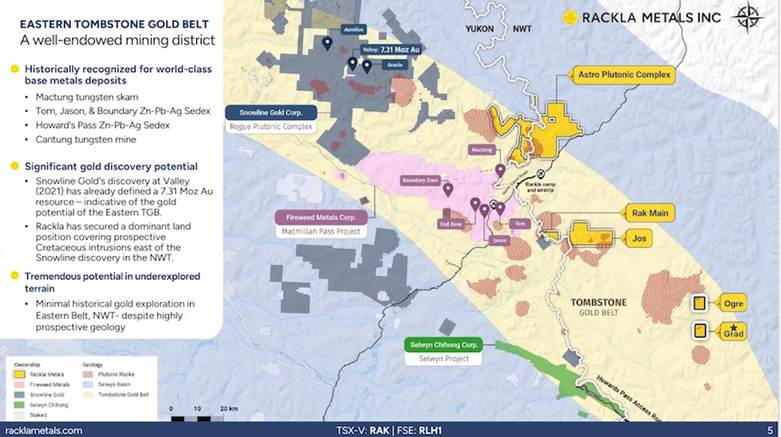
Eastern Tombstone Gold Belt
Sifting through hundreds of government geochemical surveys and mineral assessment reports related to the NWT portion of the TGB, Ridgway found anomalous bismuth readings from stream sediment samples. Why is that important? Because bismuth is a geochemical signature typical of RIRGS, along with gold, tellurium and tungsten.
When the NWT government and a local First Nation re-opened the area for mineral exploration in June 2024, Ridgway pounced.
Rackla started staking thousands of hectares and discovered the BiTe showing — an area of intense veining on a cliff face. At this site, the team defined a 550-meter-wide gold-bismuth (Au-Bi) talus-fine anomaly, with rock samples returning grades of up to 92 g/t gold.
Both ends of the channel remain open. The company has traced mineralization at BiTe for about 450 meters laterally and at least 400m vertically up the cliff.
The goal is to find something as significant as Snowline Gold’s Valley deposit. Valley is about 160 km from Grad and contains 7.94 million oz. gold in the measured and indicated category and 0.89 million oz. in the inferred.
While Rackla has not yet seen visible gold, characteristic of Snowline’s Valley and some other RIRGS deposits, which helps companies target drill holes, the lack of visible gold doesn’t discourage Ridgway, who says bismuth is a sponge for gold and they are finding lots of bismuth in the veins and disseminated in the intrusive.
Scott Casseleman, VP Exploration, was head of minerals geology for the Yukon Geological Survey between 1985 and 2015, Casselman also worked on projects in Indonesia, Argentina, Turkey, Alaska, and in Canada’s three northern territories.
The board of directors features veteran geologist Tom Garagan, a founder of B2Gold who serves as Senior VP, Exploration since 2007; Timothy Beale, who has over 35 years of experience managing exploration and development programs for major and junior mining corporations; and David Cass, who has over 25 years of industry experience including in the Americas, Australia, Turkey, Iran, South Africa and Eastern Europe. He spent 15 years with Anglo American, including six years as Exploration Manager of North America, and four years managing Anglo’s programs in Peru.
Rackla had $10 million in the Treasury as of June 11, 149.9 million shares outstanding and ~49% insider ownership. This year’s drill program at Grad is expected to use about $5 million.
Grad Project
The Grad Project is a Reduced Intrusion-Related Gold System (RIRGS), similar to that of other gold companies in the area such as Banyan, Eagle, Sitka and Snowline.
Rackla staked additional ground around the bismuth-tellurium showing — hence the BiTe zone moniker — bringing the project to 55.3 square kilometers.
Ridgway noted no one has looked at the cliff face before and no claims were previously staked on the mountain. The remote Yukon and Northwest Territories is one of the few places left in North America where you can walk into an unprospected valley and claim-stake.
The company launched its maiden drill program at Grad in early July.
Three drill pads along the base of the cliff will test a minimum 300 meters across the zone and a fourth pad has been placed along strike of the vein zone to the south. The drill holes are planned to depths of between 200 and 500 meters.
To confirm vertical continuity to the ridge top, about 350 meters above the drills, a team of mountaineering geologists are working on rope-supported spot, chip and channel sampling.
Ridgway notes the team is seeing the right core visuals: sheeted vein density and the right sulfides.
Grad is thought to be the same style of mineralization responsible for over 20 million oz. in deposits like Fort Knox, Dublin Gulch and Valley, where the bismuth veinlets are gold-bearing.
Renowned geologist Quinton Hennigh, who works for Crescat Capital, describes Grad as the same type of system as Snowline’s Valley but a different “flavor”. Both are RIRGS, but in the case of Rackla the stock work and sheeted veins have a bit of a unique mineralogy. While Snowline saw visible gold in the quartz veins, Rackla is seeing a higher abundance of bismuth and tellurium; these minerals are “basically hiding the gold in plain sight,” says Hennigh.
In an interview with AOTH, Hennigh described the drill core as full of small hairline veinlets.
“You get your hand lense out, you look at them up close and they’re absolutely full of these mysterious grey minerals, real shiny grey specks. Logic dictates that’s likely bismuth and tellurium because of the trace element analysis that has been done today, and I think there’s so much bismuth and tellurium that it’s hiding the gold as alloys or as mineral compounds that simply don’t show us visible gold. So, it’s not a bad thing it’s a good thing,” Hennigh said.
Indeed fact, where you find bismuth you almost always find gold, it’s the best indicator mineral for gold in the hunt for Yukon RIRGS.
Grad’s geometry is the inverse of Snowline because it’s outcropping from surface, whereas Valley is in a U-shaped valley made that way by glaciation. Grad is in effect a steep mountain, requiring geologists with specialized mountaineering skills.
The intrusion is of a similar scale to Valley, with the mineralization emanating from one side of the mountain to the top and over to the other side. Hennigh estimated it could be 1.5 to 2 times the strike length of Valley; the most intense sheeted veining is about 250 meters wide, wider than the high-grade core at Valley.
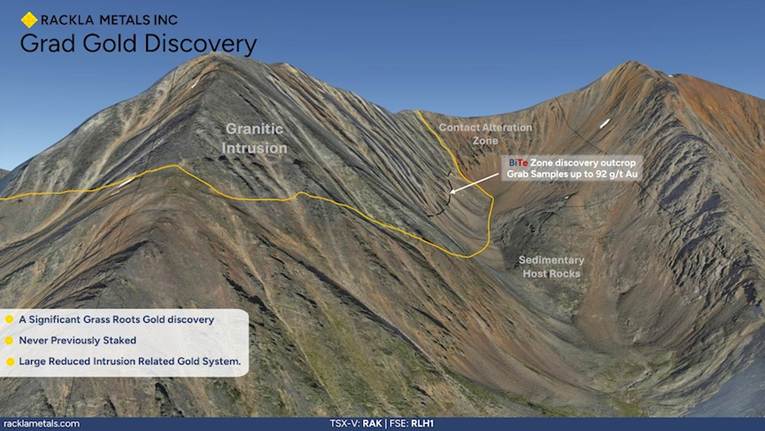
Grad gold discovery
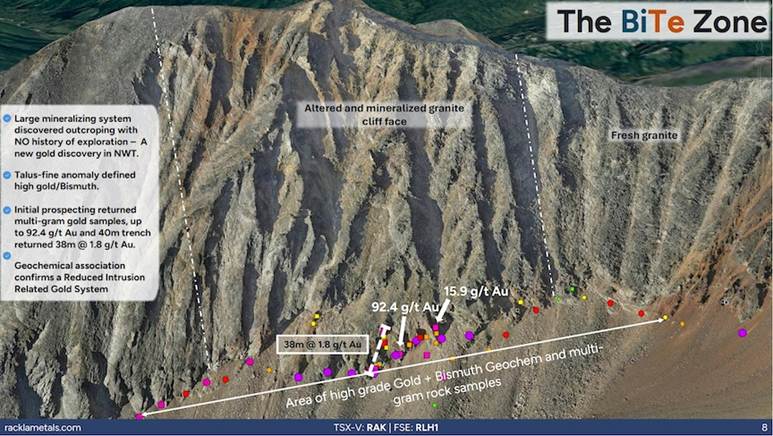
BiTe Zone
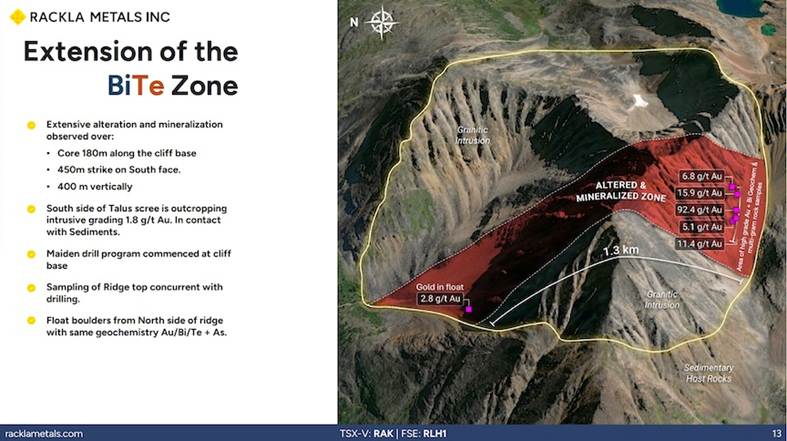
Extension of the BiTe Zone
Rackla has sampled 550 meters across the base of the ridge and came up with 1-2 grams gold; that might suggest giant potential.
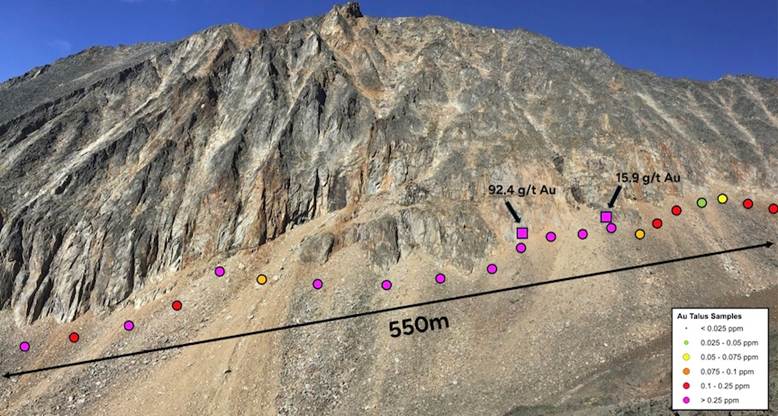
Talus line defining the BiTe Zone across 550m and initial discovery rock samples.
Indeed, the company has found a great deal of outcropping mineralization; a 400-meter cliff face from bottom to top over a strike length a little over 500 meters. When RAK chip-sampled this intrusive granite rock with sheeted quartz veins they got over a gram of gold per tonne, an average 1.06 g/t — extraordinary.
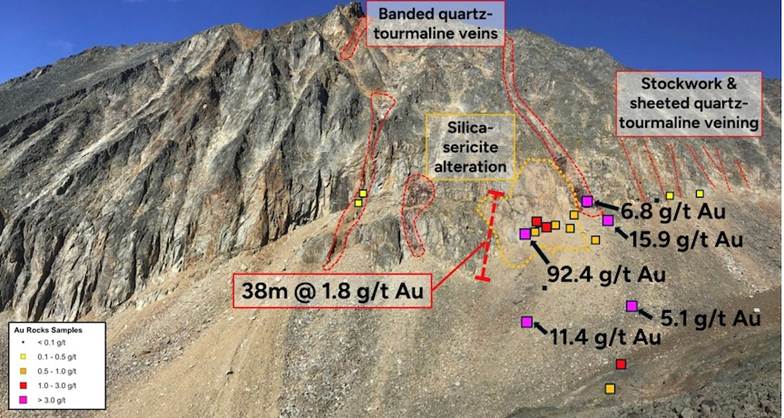
Rock samples collected on the BiTe Zone, notable a chip channel of 1.8 g/t Au over 38m.
Under the Spotlight: Ready, shoot, aim — Bob Moriarty, Quinton Hennigh, Rick Mills
The veins are what hosts the gold, so the more you see, and this has been proven many times over in these style deposits, the more likely you’re going to have better grades.
Hennigh dismissed a theory that the gold is refractory, which is hard to process. “You can likely make a concentrate out of this and actually you might be able to recover a significant amount of bismuth and tellurium, which could be appreciable byproducts,” he said, noting the high value of both bismuth and especially tellurium, a rare critical metal.
One negative is the fact that Grad is on the east side of the Tombstone Gold Belt where there is little mining infrastructure compared to the west side. But Hennigh said the remoteness of the project won’t be an issue if, like Snowline, they discover +10Moz @ high grades.
“I think if they made a discovery like that it’ll be just like Snowline, it’ll be developed, it’ll become a mine,” he said.
Rackla was pleased to host Dr. Quinton Hennigh at the Grad Project last week. He offered insights into the similarities and differences between BiTe showing mineralization and other major projects in the Tombstone Gold Belt.
The interview with Dr. Hennigh is here; https://www.youtube.com/watch?v=2NJYazaHmFQ.
RIRGS
What exactly is a Reduced Intrusion-Related Gold System? The model was developed by a famous geologist, Craig Hart. RIRGS develop from a large volume of granitic melt that forms deep in the earth’s crust. As enormous bodies of molten rock, they can occur on the scale of tens of miles, and little apophyses of melt rise up and break through the crust.
The apophyses that stick up can carry a lot of gold. Hennigh describes them as “an upside-down udder on a cow with innumerable teats.”
Maiden drill program
As of Aug. 5, 2025, Rackla had six holes drilled or in progress totaling 2,058m. All holes drilled to date have intersected a consistent set of sheeted quartz/sulfide + tourmaline veins, with vein density averaging between 5 to 10 per meter and occasionally much higher.
Rackla is pleased with the density of sheeted veining observed in all holes drilled so far and the bismuth content in the veins.
Completed holes G25-004 and 005 were logged and cut with the expectation that the samples would be shipped to the lab by the week ending Aug. 8.
The first three holes are in the assay lab, with assay results expected in the coming weeks.
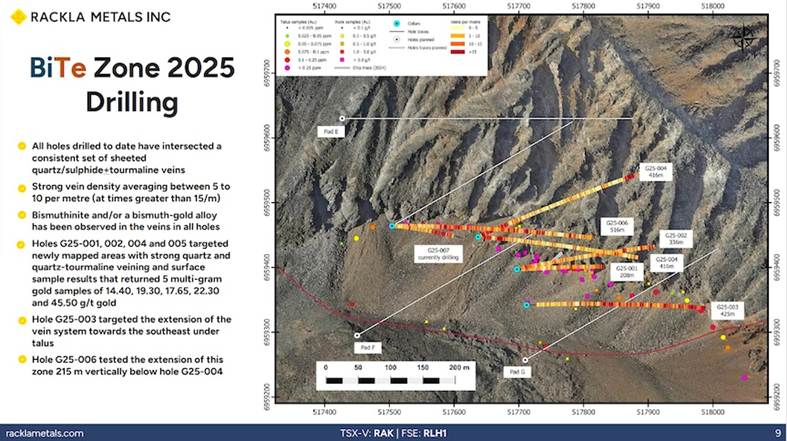
BiTe Zone drilling
On Aug. 19 Rackla said the drill plan has been increased by 25% to 5,000m due to encouraging observations in the drill core and surface work that has extended the mineralized zone at the BiTe showing significantly to the west and at depth.
As of Aug. 18, over 3,100m have been drilled with seven holes completed, testing an area measuring 500 x 300 x 550m. The drill is currently on hole G25-008.
The news release states:
All holes drilled to date have intersected a consistent set of sheeted quartz/sulfide + tourmaline veins throughout their length. A broad zone with intense quartz and quartz-tourmaline veining and elevated bismuth content was intersected at the top of holes G25-004 and 005. This zone has been intersected in holes G25-006 and 007, 125m west of G25-004 and 005. The zone shows good continuity and appears robust with increasing strength and width as the intercepts get deeper. Hole G25-008 is targeting the same zone north of the intercept in holes G25-006 and 007.
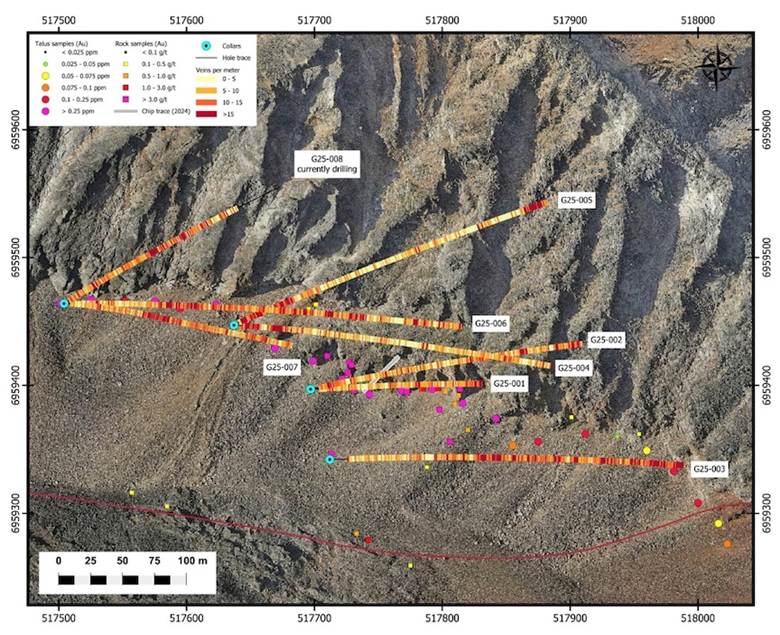
Map of the BiTe Zone with the trace of drill holes G25-001 to 007 with vein density counts.
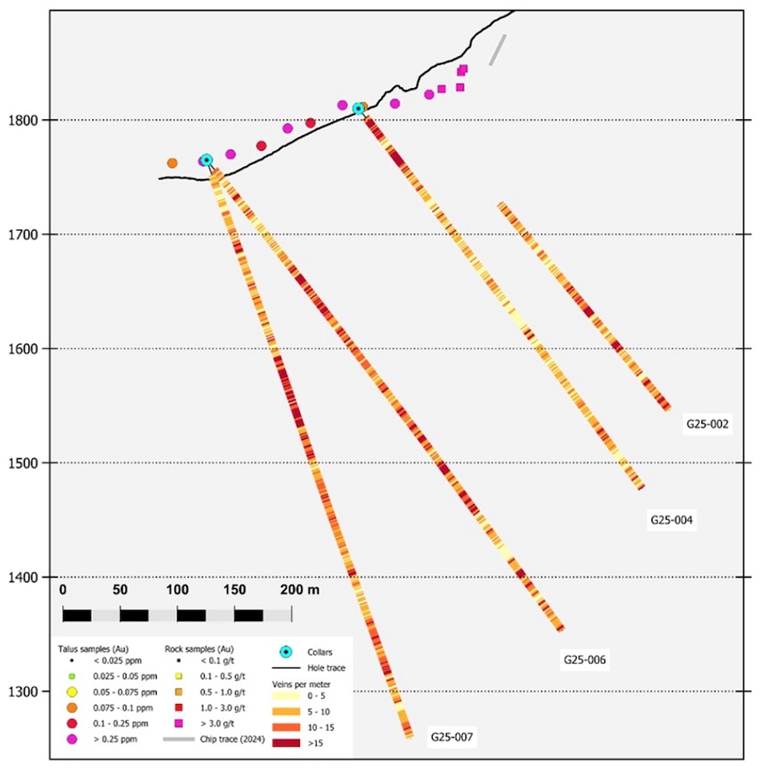
Cross section through holes G25-004, G25-006, G25-007 and the bottom of hole G25-002 (section slice is 60m wide).
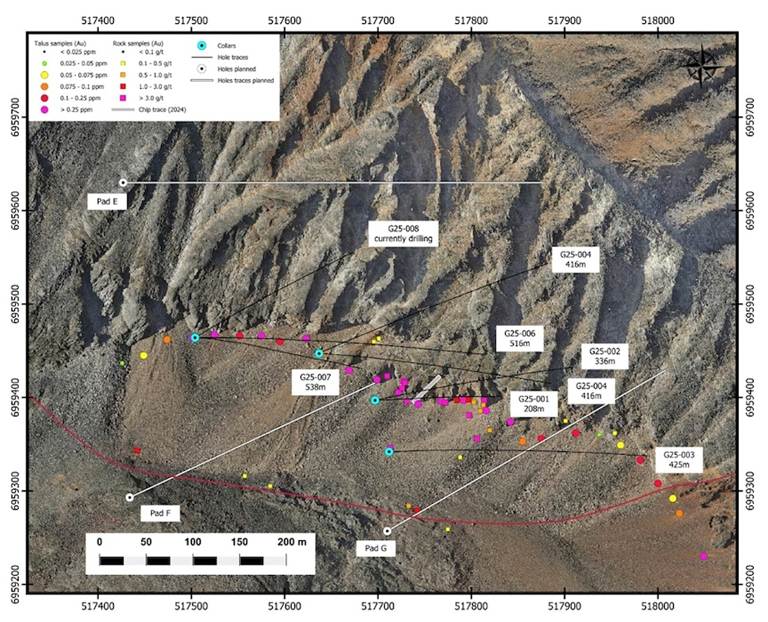
Map of completed diamond drill holes and planned future holes as of August 18th.
Rackla’s theory might be proven in just a couple of holes. Bluntly, the first few holes are going to unearth valuable information to Rackla. They aren’t going to tell RAK they’ve got 10Moz of gold, but they are going to determine whether their proposed theory is correct.
Rigway told me over the phone that “it looks like a huge alternation system” that will require longer holes, from the current 450m up to 700m. The drill crew is making good progress @ around 50m a shift. “We’re seeing the same things we’re seeing in the cliff face; it looks good. So that’s basically it: prospecting, find the sheeted veining in the intrusive, drill it,” he said.
Under the Spotlight – Simon Ridgway, Bob Moriarty & Rick Mills
They’re starting at the BiTe Zone. From each pad built at the base of the cliff, there are three orientations to the veining that they see; Rackla is not 100% sure which one, or all of them, is carrying the gold. Vein orientation and thin section studies will likely be completed this winter.
RAK is also stepping south across the talus, which is about 150m thick, and Rackla is testing underneath the talus as well. Talus is a naturally occurring slope made of a jumble of loose rocks that have fallen from a rocky cliff or other rock face above.
Ridgway says it’s looking very similar to the cliff face, so the intrusive likely continues to the other side of the talus.
Remember, when RAK chip-sampled the intrusive granite rock with sheeted quartz veins they got over a gram of gold per tonne.
The other side of the cliff is equally as steep and there is similar-looking veining there, although the geochemistry is slightly different from the BiTe Zone. Crews will drill from the southern face along the 550m anomaly and cut into the mountain.
For the final holes of the year, Rackla will work their way to the end of the alteration zone, where some fresh granite at the end of the 550-meter-wide gold-bismuth talus-fine anomaly was sampled.
Geologists will climb about halfway up the mountain to the slope break and build a drill pad. From there, two 700-meter holes will cut into the mountain, testing some 300 meters laterally from the other holes. “So that’s how we’re testing this broad area, we’ll be getting all of the gold coming down,” says Ridgway.
“We’re getting some broad intervals of nice veining, so I’m very encouraged that we’ll be back in here big-time next year” with a significantly larger drill program, he added.
Permitting in the Northwest Territories is efficient and fast, Ridgway noted.
The now-5,000m drill program will give Rackla a good idea if they have continuity of mineralization throughout the deposit, which is around the same size as Snowline’s Valley.
Plans going forward include building an air strip and camp at the project so that they don’t have to rely on helicopters to transport supplies and personnel from their current camp, which being a 40-minute flight away is time-consuming and expensive.
Conclusion
Rackla’s flagship Grad Project is a 100%-owned grassroots gold discovery in an underexplored portion of the Tombstone Gold Belt — a rapidly emerging multi-million-ounce district.
A 40-meter trench returned 38m @ 1.8 g/t Au with consistent bismuth (450 ppm) and tellurium (25 ppm).
The current 5,000m drill program is testing a 600 x 350 x 500m target area at the BiTe Zone.
It looks like the holes as they get deeper show an increase in veining. The more veins, the more likely it’s going to carry higher grades.
The intrusive is poking through the sediments but Rackla still has the whole carapace below them to test.
Initial prospecting returned multi-gram gold samples, up to 92.4 g/t Au, and a 40m trench returned 38m @ 1.8 g/t Au. The 92-grams-gold sample was taken from am especially intensely altered area, of which BiTe has several, and ran an extraordinary ~2% bismuth — a strong pathfinder mineral for gold.
The math is starting to look compelling, soon we’ll be able to plug some hard numbers into our equation.
500 X 500 X 400m mineralized triangle X a specific gravity of 2.6-2.7 X grade
We’re not going to have to wait long to find out information on the depth, the grade and the continuity of an area about the same size as Snowline’s deposit. Confirm the above measurements, make sure the ore body hangs together, plug in the average grade and soon it could get very exciting for RAK shareholders.
To date seven holes are complete. The core from five holes is already in the lab; we’re expecting assay results within a few weeks.
Rackla Metals Inc
TSXV:RAK
Cdn $0.70 2025.08.19
Shares Outstanding 149.9m
Market Cap Cdn$96.3m
RAK website
Subscribe to AOTH’s free newsletter
Richard does not own shares of Rackla Metals Inc (TSX-V:RAK). RAK is a paid advertiser on his site aheadoftheherd.com This article is issued on behalf of RAK
Legal Notice / Disclaimer
Ahead of the Herd newsletter, aheadoftheherd.com, hereafter known as AOTH.
Please read the entire Disclaimer carefully before you use this website or read the newsletter. If you do not agree to all the AOTH/Richard Mills Disclaimer, do not access/read this website/newsletter/article, or any of its pages. By reading/using this AOTH/Richard Mills website/newsletter/article, and whether you actually read this Disclaimer, you are deemed to have accepted it.
MORE or "UNCATEGORIZED"
Visionary Copper and Gold Mines Inc. Closes Final Tranche of Private Placement Financing
Visionary Copper and Gold Mines Inc. (TSX-V: VCG) (OTCQX: VCGMF) ... READ MORE
PAN GLOBAL STEP-OUT DRILLING EXTENDS LA ROMANA DEPOSIT AT ESCACENA PROJECT, SOUTHERN SPAIN
Highlights include 1.26% copper, 0.01% tin, 2.3 g/t silver over 6... READ MORE
Sorbie Bornholm Announces New Investment of $6,000,000 in Homerun Resources
Sorbie Bornholm LP, a UK investment fund, is pleased to announce ... READ MORE
G2 Goldfields Delivers Maiden PEA for the High-Grade Oko Gold Project
PEA Highlights: High-grade updated resource: Underpinned by G2’... READ MORE
Titan Mining Closes US$15 Million Institutional Financing to Advance U.S. Graphite Strategy
Titan Mining Corporation (TSX:TI) (NYSE-A:TII), an existing zinc ... READ MORE












